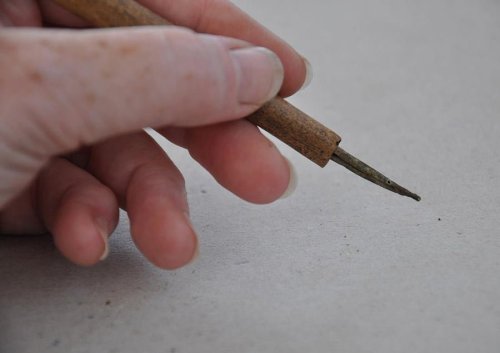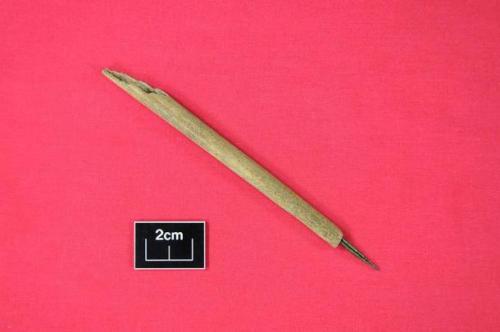blueiskewl: 1,000-Year-Old Ink Pen Found in Ireland An archaeologist excavating at an 11th century r
blueiskewl: 1,000-Year-Old Ink Pen Found in Ireland An archaeologist excavating at an 11th century ringfort in Ireland has unearthed the oldest ink pen ever discovered in Ireland. What’s unusual, is that this artifact was a secular work tool used for writing legal documents. It wasn’t used to create iconic medieval Christian works of art. Dating back 1,000 years, Ireland’s oldest known ink pen was unearthed by archaeologist Michelle Comber of the National University of Ireland (NUI) Galway. Dr Comber discovered the artifact within an 11th-century archaeological layer at the Caherconnell Cashel ringfort, County Clare, Ireland.The ink pen features a hollowed bone barrel and a copper-alloy nib. Because ringforts were the homes of wealthy agriculturalist-rulers it is perhaps no surprise that this device would be found at such a site. But what’s unusual in this discovery, according to Dr Comber, is that the pen was found “in a secular setting,” rather than in a religious setting.The discovery of the pen is the crown jewel of the Caherconnell Archaeology project . Over the last three years, a team of multi-disciplined researchers has field-surveyed the entire area between Kilfenora in the southwest to Carran in the northeast in Ireland.First built in the late 10th century the Caherconnell Cashel ringfort was enhanced and rebuilt by local rulers until the early 17th century. The 140-foot-wide (140-meter-wide) superstructure had 13-feet (4-meter) high, 10-foot-thick (3-meter-thick) drystone walls. According to a report in the Clare Herald , the pen was discovered among “fine craftworking and metalwork tools , to items of trade, gaming and music” at the ringfort site in Ireland.The pen stands out from the other artifacts recovered at the site because it was different from what is normally expected in terms of secular ringfort artifacts. Pens and other writing tools are usually unearthed at Irish religious sites where scribes copied older texts, like the highly illustrated 800-AD Book of Kells, which is a priceless example of mediaeval Irish calligraphy skills.Dr Comber had experimental archaeologist, Adam Parsons, of Blueaxe Reproductions, fabricate a replica of the pen to determine if the artifact might have functioned as a writing tool, or more specifically a “dip pen,” like he suspected it would. Dip pens have no ink reservoir within the barrel, unlike the fountain pens and feather quills that were much more popular in the 11th century. Hence, the Caherconnell pen is unique in the way it functioned.Several copper-alloy pen nibs have been discovered dating to the Roman Britain era, and many more from between the 13th and 16th centuries AD. However, Dr Comber told the MailOnline that the bone-and-metal Caherconnell pen is the “earliest complete example of a composite pen ever discovered in the British Isles.” And the archaeologist was clear that this pen wasn’t used for medieval Irish religious arts, but for recording family lineages and trade information.Calligrapher and historian Tim O’Neill told the MailOnline that the design of the Caherconnell pen “would have lent it well for use on fine work - perhaps even the drawing of fine lines.” He added that because the copper nib pen was dipped in ink it would have worked well for “ruling straight lines to form, for instance, a frame for a page.”It can be argued that the creation of the ink pen was a monumental step in the formation of human civilization, for with writing we can create new ideas, share old ones, and learn in structured ways. The oldest ink writing ever discovered was penned onto papyrus around 2600 BC in Egypt.Hollow, tubular, bamboo plant reeds were filled with ink and squeezed gently to maintain a constant ink flow when writing. Over time, grasses and reeds were replaced with bird feathers. Between the 7th and 19th century AD, Europeans preferred the stiff thick feathers of swans, turkeys, and geese.Wherever Ancient Origins’ writers see a chance to generate an “Ah, so that’s where it came from” moment for readers, we grab it. According to Journal Shop’s brief history of pens, medieval Brits carefully removed any natural oils that may have contaminated the ink before they shaped the feather with a sharpened knife. The quality of the sharp end of the pen greatly determined the resolution of the final writing, thus, it was always said that a writer should have a good quality “pen-knife.”By Ashley Cowie. -- source link


